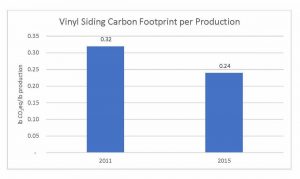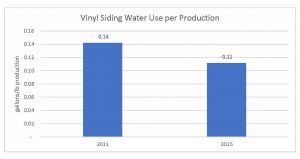The Birds and the BEES of Vinyl Siding’s Sustainable Benefits
The vinyl siding industry has taken sustainability seriously over the past two decades – and is far ahead of the other claddings producers in this category. Within the last 10 years, the Vinyl Siding Institute’s (VSI) work in this area has been well-documented, as evidenced by the different BEES studies that they have commissioned in recent years. BEES (Building for Environmental and Economic Sustainability software) is a tool developed by the National Institute of Standards and Technology that measures the life cycles of different types of building products.
The latest BEES analysis compared water use and carbon emissions at eight polymeric siding manufacturing facilities between 2011 and 2015; as well as the amount of water used in the manufacturing of polypropylene siding and average vinyl siding vs. the amount of water used by other claddings in their processes (in 2015).
Improvements in carbon emissions and water use by the vinyl industry
When you look at both graphs, you see measurable decreases in carbon emissions by the industry, as well as a strong indication that the whole industry by facility is working hard to reduce their carbon impact.


According to Cara Vought, Technical Manager for Sustainable Solutions Corporation (the consulting firm that works closely with VSI on its recycling and sustainability initiatives), “there is a big movement out there to measure carbon impact, so the data shows that the vinyl siding industry is using innovation and effort to decrease these impacts. Any decrease, especially for the entire industry, is always a good thing when considering the harmful effects of carbon emissions on global warming. Most industries are still working to establish a baseline (or starting point). The vinyl siding industry established their baseline 10 years ago.”
Vought believes that carbon emissions from vinyl siding manufacturers will continue to come down. The VSI will be adding another update in 2022 as part of their ongoing research, which is anticipated to show more decreases across the board.
A review of the water use graph shows a downward trend similar to the carbon progress, but with higher reductions. Vought asserted that the industry’s commitment to decreasing both is equally important.
Vinyl siding ranks among the exterior industry leaders in water use levels
Compared to other claddings, only brick and mortar and aluminum siding are competitive with vinyl siding, insulated vinyl siding and polypropylene siding. All the other categories, including fiber cement, stucco and cedar siding, use at least three times the amount of water that polymeric siding uses in their manufacturing processes. Vought acknowledged that the other cladding sectors have implemented water reduction projects, and that the others have maintained use without increases, which is also encouraging, especially when considering the increases in product demand and other variables over time. The vinyl siding industry has one distinct strategy when it comes to water use.
“All (polymeric siding) facilities have closed-loop water systems, so they are recycling water,” Vought noted. “This is what you want for any type of extrusion process.”
Unlike any cladding that has to be painted or finished, polypropylene and other polymeric siding products do not require higher water use – especially when multiple painting is required.
“Recent updates in the BEES* tool have allowed for more accurate measures that further demonstrate vinyl siding and polypropylene as industry leaders in sustainability,” Vought asserted. “I don’t know if other claddings have provided recent data to BEES. You may get company-specific data, but nothing else that shows what an entire industry is doing like polymeric siding.”
As the industry continues to work hard to improve carbon emissions reductions and water use, the VSI looks forward with confidence to see what the data will look like in 2022.
As vinyl siding production increases, so will their sustainable efficiencies.
Don Browne is a writer, entrepreneur and local legislator who believes that the power of words can change the world. He provides unique writing services for clients in the construction, health care, IT and hospitality sectors. He has a passion for small business and start-ups, as well as writing about Irish history, family and corporate biographies. As a homeowner and father of four who is passionate about community development, Don looks forward to writing more about the exciting possibilities of creating traditional neighborhoods and more sustainable communities using modern materials.


